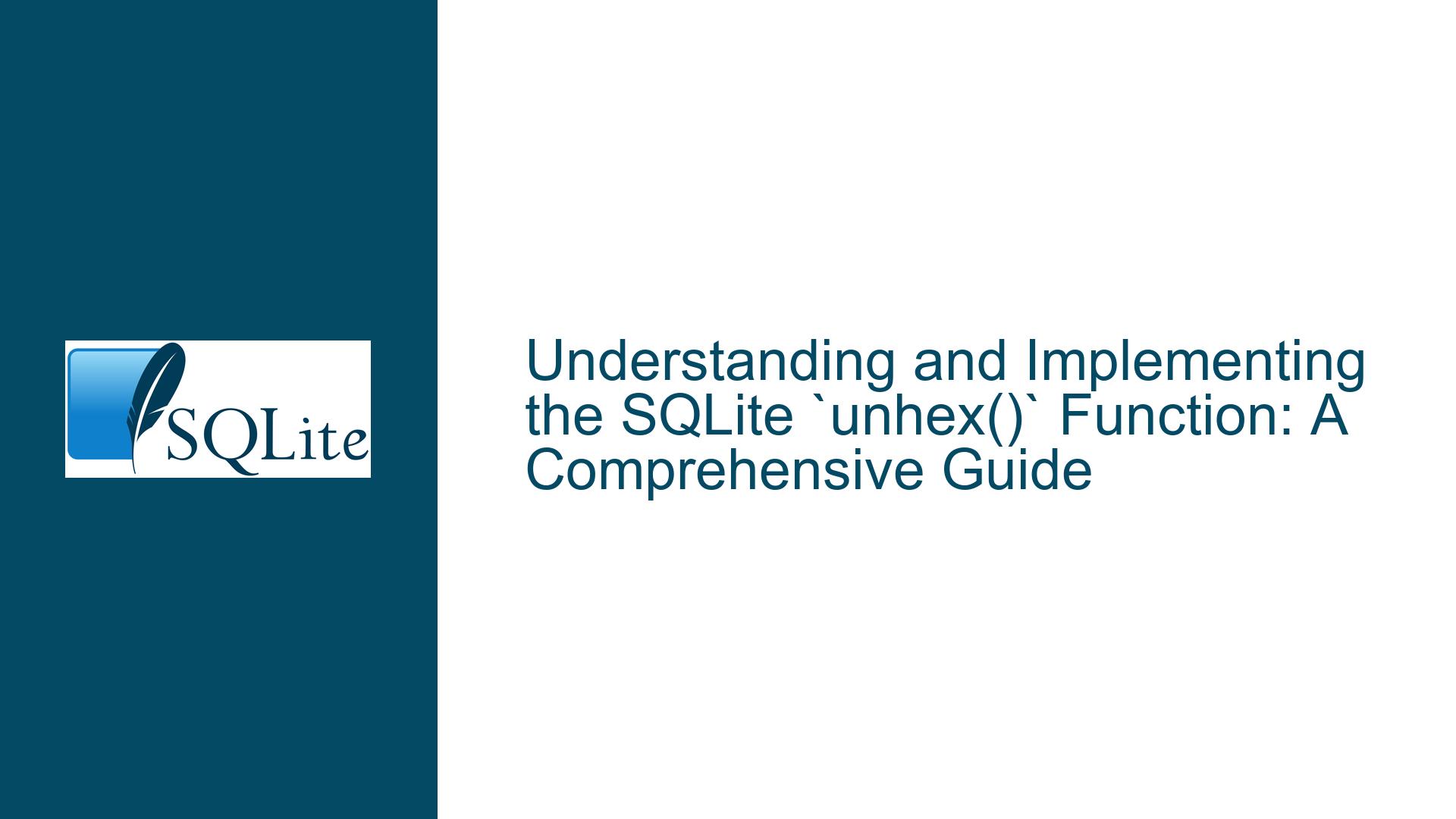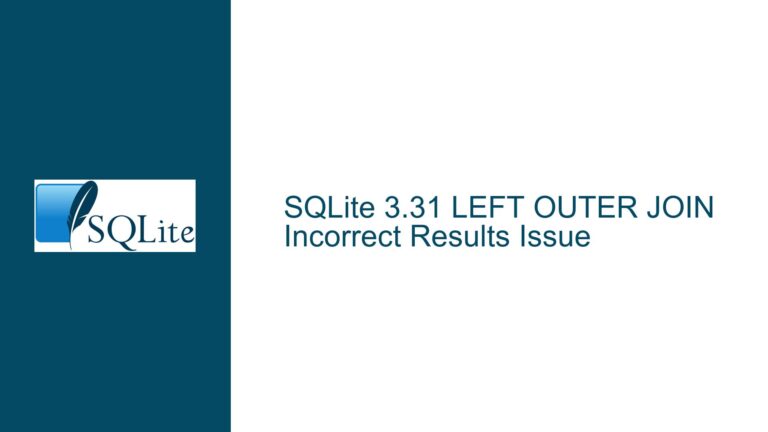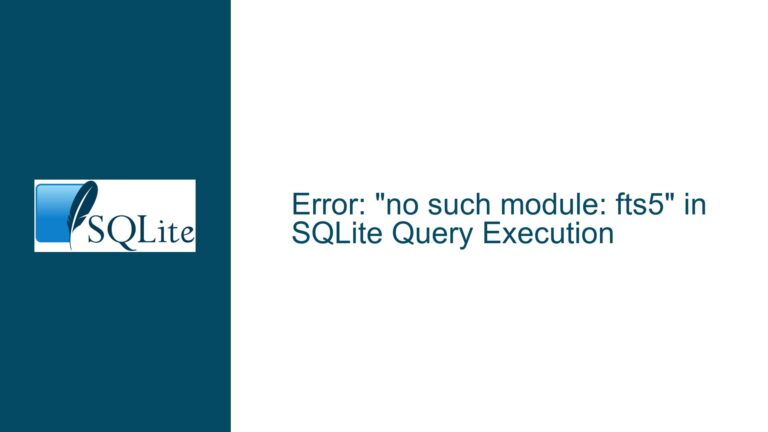and Implementing the SQLite `unhex()` Function: A Comprehensive Guide
Issue Overview: The Need for a Robust unhex() Function in SQLite
The unhex() function in SQLite is designed to convert a hexadecimal string into a binary blob. This functionality is particularly useful in scenarios where data is stored or transmitted in hexadecimal format and needs to be converted back to its binary representation for further processing or storage. The function must handle various edge cases, such as invalid characters, odd-length strings, and optional separators like whitespace or hyphens. The goal is to ensure that the function is both flexible and strict, returning NULL when the input does not meet the specified criteria.
The function’s behavior is defined by the following rules:
- It accepts a single text argument containing hexadecimal digits.
- If the text contains any characters other than uppercase or lowercase hexadecimal digits, whitespace, or hyphens, the function returns
NULL. - If the text contains an odd number of hexadecimal digits or if any pair of hexadecimal digits is separated by whitespace or a hyphen, the function returns
NULL. - Otherwise, the function removes all whitespace and hyphens, converts the remaining hexadecimal string into a blob, and returns the blob.
The function has been extended to support an optional second argument, which specifies additional characters that can be ignored between pairs of hexadecimal digits. This allows for greater flexibility in handling input strings that may contain various separators.
Possible Causes: Challenges in Designing and Implementing unhex()
The design and implementation of the unhex() function present several challenges, each of which must be carefully addressed to ensure the function behaves as expected in all scenarios.
1. Handling Invalid Characters
One of the primary challenges is determining how to handle invalid characters in the input string. The function must distinguish between valid hexadecimal digits (0-9, A-F, a-f) and invalid characters. If any invalid characters are present, the function should return NULL. This requires a robust mechanism for character validation, which must be efficient to avoid performance bottlenecks.
2. Managing Odd-Length Strings
Another challenge is handling input strings with an odd number of hexadecimal digits. Since each byte is represented by two hexadecimal digits, an odd-length string cannot be fully converted into a binary blob. The function must detect this condition and return NULL to indicate an error.
3. Supporting Optional Separators
The function must also support optional separators, such as whitespace or hyphens, between pairs of hexadecimal digits. This adds complexity to the parsing logic, as the function must ignore these separators while ensuring that they do not appear within a single byte (i.e., between two hexadecimal digits that form a single byte). The introduction of a second argument to specify allowed separators further complicates the implementation, as the function must dynamically adjust its parsing logic based on the provided separators.
4. Ensuring Round-Trip Consistency
A key requirement for the unhex() function is that it should work seamlessly with the hex() function to ensure round-trip consistency. Specifically, the expression unhex(hex(value)) should return the original value. This requires careful handling of edge cases, such as empty strings or NULL values, to ensure that the function behaves predictably in all scenarios.
5. Performance Considerations
Finally, the function must be efficient, especially when processing large input strings. The parsing logic must be optimized to minimize overhead, and the function should avoid unnecessary memory allocations or copies. This is particularly important in scenarios where the function is used in high-throughput applications or on resource-constrained devices.
Troubleshooting Steps, Solutions & Fixes: Implementing and Optimizing unhex()
1. Implementing Character Validation
To handle invalid characters, the function must first validate the input string. This can be done by iterating through each character in the string and checking if it is a valid hexadecimal digit, whitespace, or hyphen. If any invalid characters are found, the function should immediately return NULL. This validation step should be performed before any further processing to ensure that the function fails fast in the presence of invalid input.
2. Detecting Odd-Length Strings
After validating the input string, the function must check if the string has an odd number of hexadecimal digits. This can be done by counting the number of valid hexadecimal digits in the string and checking if the count is even. If the count is odd, the function should return NULL. This check should be performed after removing any optional separators to ensure that the count is accurate.
3. Parsing with Optional Separators
To support optional separators, the function must first remove any characters specified in the second argument from the input string. This can be done by iterating through the string and skipping over any characters that match the allowed separators. The function must then ensure that no separators appear within a single byte (i.e., between two hexadecimal digits that form a single byte). If any such separators are found, the function should return NULL.
4. Ensuring Round-Trip Consistency
To ensure round-trip consistency with the hex() function, the unhex() function must handle edge cases such as empty strings and NULL values. Specifically, unhex('') should return an empty blob, and unhex(NULL) should return NULL. Additionally, the function must ensure that the conversion from hexadecimal to binary is accurate, with each pair of hexadecimal digits correctly representing a single byte in the resulting blob.
5. Optimizing Performance
To optimize performance, the function should minimize the number of passes over the input string. This can be achieved by combining the validation, separator removal, and parsing steps into a single pass. Additionally, the function should avoid unnecessary memory allocations by pre-allocating the output buffer based on the length of the input string. Finally, the function should use efficient string manipulation techniques, such as pointer arithmetic, to reduce overhead.
Example Implementation
Here is an example implementation of the unhex() function in C, which incorporates the above considerations:
#include <sqlite3.h>
#include <ctype.h>
#include <string.h>
static void unhexFunc(sqlite3_context *context, int argc, sqlite3_value **argv) {
const char *input = (const char *)sqlite3_value_text(argv[0]);
const char *separators = (argc > 1) ? (const char *)sqlite3_value_text(argv[1]) : NULL;
int inputLen = strlen(input);
int i, j = 0;
char *output = sqlite3_malloc(inputLen / 2 + 1);
if (!output) {
sqlite3_result_error_nomem(context);
return;
}
for (i = 0; i < inputLen; i++) {
char c = input[i];
if (separators && strchr(separators, c)) {
continue;
}
if (!isxdigit(c)) {
sqlite3_free(output);
sqlite3_result_null(context);
return;
}
if (j % 2 == 0) {
output[j / 2] = (hexCharToInt(c) << 4);
} else {
output[j / 2] |= hexCharToInt(c);
}
j++;
}
if (j % 2 != 0) {
sqlite3_free(output);
sqlite3_result_null(context);
return;
}
sqlite3_result_blob(context, output, j / 2, sqlite3_free);
}
static int hexCharToInt(char c) {
if (c >= '0' && c <= '9') {
return c - '0';
} else if (c >= 'A' && c <= 'F') {
return c - 'A' + 10;
} else if (c >= 'a' && c <= 'f') {
return c - 'a' + 10;
}
return 0;
}
This implementation validates the input string, handles optional separators, and ensures that the output is a valid binary blob. It also checks for odd-length strings and returns NULL if any errors are detected. The function is optimized for performance by minimizing memory allocations and using efficient string manipulation techniques.
By following these steps and considerations, you can implement a robust and efficient unhex() function in SQLite that meets the requirements outlined in the discussion. This function will be a valuable tool for converting hexadecimal strings into binary blobs, enabling seamless data processing and storage in a wide range of applications.






